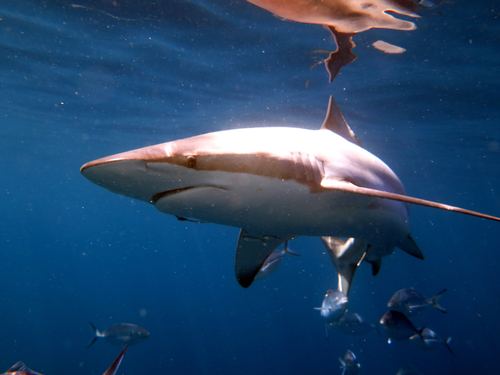
Copper Shark
Bluefin Tuna are among the largest and fastest fish in the ocean, renowned for their incredible migrations and high commercial value. These apex predators play a crucial role in marine ecosystems, but are under significant threat due to overfishing.
12 30 years
Lifespan
330 cm
Length
Vulnerable
Conservation Status
36 km/h
Swimming speed
Carnivorous
Diet
Seasonal Migration
Migration
Appearance Overview
The Bluefin Tuna is renowned for its large, streamlined body, built for speed and endurance.
Color
Dark metallic blue on top with a silvery underside
Fins
Two dorsal fins, the first depressible; small, yellow finlets run down the back and belly to the tail.
Body Shape
Torpedo-shaped, designed for efficient swimming.
Length
Up to 10 feet (3 meters), commonly 6.5 feet (2 meters)
Weight
Up to 1,500 lbs (680 kg), commonly around 550 lbs (250 kg)
Diet
Carnivorous, feeding on fish, squid, crustaceans, and occasionally on plankton and algae.
Feeding Behavior
Uses speed to chase down prey, sometimes hunting cooperatively with other tuna to herd and capture schooling fish.
Social Behavior
Highly migratory, forming large schools, especially during spawning season; often segregated by size.
Commercial Relevance
Extremely high value, particularly in sushi and sashimi markets, where a single fish can be sold for thousands of dollars.
Conservation measures
International fishing quotas, seasonal closures, size limits, and efforts to reduce bycatch in other fisheries.
Status
Atlantic Bluefin Tuna: Endangered; Pacific Bluefin Tuna: Vulnerable; Southern Bluefin Tuna: Critically Endangered
Threats
Overfishing driven by high market demand, bycatch in other fisheries, and changing ocean conditions due to climate change.
Habitat Distribution
Depth Range
0-900 meters, though they are most commonly found in the upper 300 meters of the water column.
Geographic Range
Atlantic Bluefin Tuna: Western and Eastern Atlantic, Mediterranean Sea; Pacific Bluefin Tuna: Widespread across the Pacific Ocean; Southern Bluefin Tuna: Southern Hemisphere oceans
Preferred Environment
Temperate and subtropical waters; open ocean and coastal areas, often associated with ocean currents.
Reproduction and Life Cycle
Breeding Habits
Spawns in warm waters; Atlantic Bluefin Tuna have two main spawning grounds: the Gulf of Mexico and the Mediterranean Sea.
Development Stages
Eggs hatch into larvae, which develop rapidly in plankton-rich waters, growing into juveniles and eventually adults.
Fecundity
Females can produce up to 30 million eggs per season, releasing them in batches.
Maturity Age
Atlantic Bluefin Tuna: 4-8 years; Pacific Bluefin Tuna: 3-5 years; Southern Bluefin Tuna: 8-12 years
Faqs about Copper Shark
Where are Bluefin Tuna found?
Bluefin Tuna are found in the Atlantic, Pacific, and Indian Oceans, as well as the Mediterranean Sea.
Are there different species of Bluefin Tuna?
Yes, there are three main species: Atlantic, Pacific, and Southern Bluefin Tuna.
How long do Bluefin Tuna live?
Bluefin Tuna can live up to 40 years, though this varies by species.
How fast can Bluefin Tuna swim?
Bluefin Tuna can reach speeds of up to 43 mph (70 km/h).
Why are Bluefin Tuna endangered?
Overfishing is the primary reason, fueled by high demand for sushi and sashimi.
Copyright @ Nature Style Limited. All Rights Reserved.
 English
English